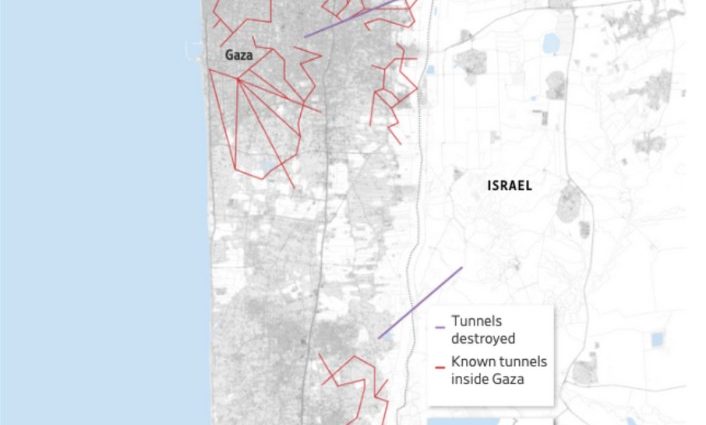Hamas may have devised a devious aqueous trap for invading Israeli forces, waiting for the opportune moment to strike as the Gaza war enters a dangerous new underground phase.
Last month, ETV Bharat reported that Hamas is planning to use its tunnel-fighting prowess to counter and frustrate Israel’s ground offensive in the Gaza Strip’s northern region.
According to a “what if” memo prepared by the New Delhi-based think tank ImagIndia, Hamas could potentially create a seawater flood in Gaza by remotely exploding a bomb on the Mediterranean coast, ETV Bharat reported.
The report notes that Hamas’ tunnels are on average 50 feet under Gaza land but they can also be dug at a depth of just three to four feet underground to link to the Mediterranean Sea coast.
It says if Israel pushes deeper into Gaza, the seawater will rush in via the tunnels and flood the low-lying areas, creating a marshy belt around four kilometers, making it virtually impossible for Israeli trucks and tanks to move.
The report mentions the US approved the sale of precision-guided weapons to Tel Aviv in May this year while the Israeli military also has the option to use US-made “bunker buster” GBU-28 bombs on the tunnels. But dropping bunker busters in response to a Hamas seawater flood bomb blast would further aggravate the situation, drastically increasing the size of flooded areas.
As using bunker-buster bombs may not be an option, unofficial sources have said that Israel could instead pump a chemical agent into the Hamas tunnel network to smoke out militants and facilitate the rescue of hostages.
Flooding from the sea has been used as a scorched earth area denial strategy for centuries. For instance, at the 1574 Siege of Leyden during the Dutch War of Independence, the Dutch destroyed the dikes on the Maas River, which held back the North Sea, flooding the countryside and forcing the Spanish to retreat.
Another decisive use of flooding as a military strategy was the 1938 destruction of the Yellow River dikes during the Second Sino-Japanese War. By destroying the dikes, the Chinese prevented the Japanese from capturing Shaanxi, Sichuan and Chongqing, albeit at an immense human cost.
More recently, the June 2023 destruction of the Kakhovka Dam, which was then under Russian control, caused severe flooding in Kherson Oblast and delayed Ukraine’s counteroffensive in the region.

Jeff Goodson, in an article this month for RealClearDefense, notes that Israel could opt to flood Hamas tunnels to force the enemy above ground, reduce Israeli casualties and resolve the problem of dealing with deep tunnel warfare. He notes that in 2015 Egypt flooded 37 cross-border tunnels in Gaza, setting a precedent for the strategy.
Goodson notes that flooding could be a permanent or near-permanent solution to Israel’s Gaza tunnel problem, as pumping them out would be costly and complex for Hamas.
He writes that Israel could pump seawater from the Mediterranean directly into the tunnel openings through pipelines and that the most direct route to the entrances would require clearing and holding construction sites.
Goodson also suggests that flooding Gaza’s tunnels would reduce civilian casualties while also serving as a long-term area denial strategy for Israel against Hamas.
John Spencer mentions in an article last month for the Modern War Institute that Hamas will likely use its tunnel infrastructure offensively to launch protected surprise attacks, including to infiltrate behind Israeli positions to surprise forces that might not be as well-prepared or sufficiently equipped for combat.
Spencer also suggests Hamas will use its tunnels defensively to escape Israeli observation and attack, allowing fighters to move between fighting positions safely under massive buildings. He says that entering tunnels presents unique tactical challenges for troops, not least poor vision, thin oxygen and the need to carry and use specialized equipment.
Spencer notes the potential for a single Hamas defender to hold a narrow tunnel against a much superior Israeli force.
He writes that while Israel has developed unique tactics and equipment for Gaza tunnel warfare, the depth and scale of the subterranean infrastructure likely surpass Israel’s specialized capabilities and that success on the underground battlefield will ultimately come down to infantry and engineers effectively dealing with issues as they emerge.
Spencer also notes that finding and destroying Hamas’ tunnels will be complicated by terrain, the possibility of Hamas using civilian human shields and the need for a situation-dependent mix of capabilities, which will require a significant amount of time to develop.
Hamas’ possible combined use of targeted intentional flooding with underground warfare elsewhere goes against conventional wisdom that Israel is more likely to flood the tunnels and could serve to negate Israel’s overwhelming conventional military firepower advantage.

Increasing urbanization and rapid advances in target acquisition and precision strike capabilities mean that subterranean warfare will likely play a bigger role in coming conflicts, especially in asymmetric fights between insurgent and government forces.
In an August 2023 article in the peer-reviewed Studies in Conflict & Terrorism journal, Daphne Richemond-Barak and Stefan Voiculescu-Holvad highlight how subterranean warfare is merging with urban warfare, noting that many major cities have hidden underground passages to house and protect critical infrastructure.
They say that urban tunnels running under densely populated areas present a growing risk to civilian safety and infrastructure when targeted for destruction, as is the case now in Gaza.

